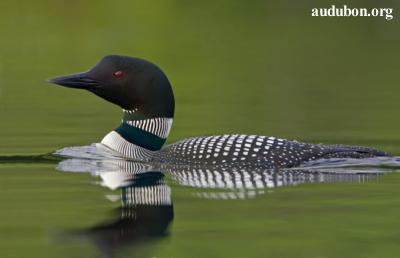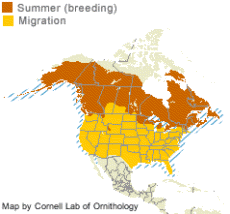 Common Loon Common LoonGavia
immer [gav' E uh im' mer]
Description
This large waterbird is 26 to
36 inches long, has a wingspan of 41 to 52
inches, and may weigh as much as 13 pounds. Both
sexes have similar plumage, but the male is
significantly larger than the female. During the
breeding season, the head, neck, wings, and sides
are black, the back has large white checkered
markings, the chest is white, and the neck is
marked by a white ring with vertical black bars.
Outside of the breeding season, the loon has gray
to gray-brown upperparts, white underparts and
throat, a wedge of white extending from throat to
back of the neck, and a white crescent around
each eye.
 Distribution and Habitat Distribution and Habitat
Loons breed across Alaska and
Canada, southward into the northern United States
and the Yellowstone region, as well as in
Greenland and Iceland; they are also occasionally
seen in Scotland. They winter along both coasts
of North America, and inland on large lakes from
Alaska to southern Mexico and from Newfoundland
to eastern Mexico; in Europe they winter from
Iceland to the Mediterranean.
Loons breed on clear freshwater
lakes with rocky shorelines surrounded by forest,
as well as on subarctic tundra lakes. They stage
for migration on large lakes and rivers, and
spend their winters in coastal marine areas near
shore or on large freshwater lakes.
Reproduction
The nest is a large mass of
plant material, sometimes placed on top of a
muskrat mound, usually located along the shore of
a lake or on a floating island. A typical clutch
consists of two to four brown eggs with dark
splotches.
Diet
Common loons swim underwater to
catch fish and aquatic invertebrates. They
swallow most of their prey underwater.
Habits and Behaviors
Loons require a considerable
amount of open water in order to gain enough
speed to take flight. It is not uncommon for a
loon to find itself stranded on a pond or other
body of water that is too small.
Scientific
Classification
phylum Chordata
subphylum Vertebrata
class
Aves
order
Gaviiformes
family Gaviidae
genus & species Gavia immer
Questions or comments about
this page?
|



